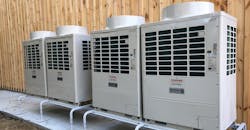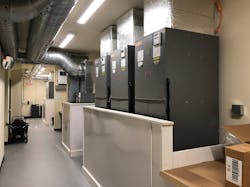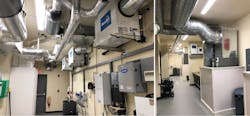Seeking increased business opportunities, contractors can look to variable refrigerant flow (VRF), a growing segment in the HVAC marketplace, as an added piece to their business arsenal. Why VRF? “If you don’t offer VRF, then you are missing out on the next century,” says Brian Nelson, principal, Nelson Mechanical Design, Inc., Edgartown, Mass. “Everything will be going electric—solar PV, wind, etc.—and you can’t cool your home with a propane boiler. But you can heat and cool a building with VRF and solar PV. We see that Massachusetts has made the governmental decision to promote VRF and discourage fossil fuels, which is great if you choose to dive into VRF.”
Moreover, bigger picture, VRF is helping in the fight to lower carbon footprints nationwide. For instance, Mitsubishi Electric Trane HVAC US (METUS) is actively providing technology and expertise to support city governments that are conducting pilot projects related to strategic electrification.
“Our VRF systems run on electricity and are ideal for applications involving renewable energy. Because VRF systems use only the precise amount of electricity needed to heat or cool a building, VRF mitigates challenges associated with battery limitations and increased strain on the electrical grid. Smart controls and sensors enable VRF systems to contribute by allowing VRF systems to operate more intelligently and efficiently in response to user demands and environmental conditions,” says Mike Smith, senior manager of marketing communications, Mitsubishi Electric Trane HVAC US.
Yet, fear of the unknown is always the biggest obstacle in pursuing new opportunities. For people in the trades, VRF can be considered an overwhelming learning curve. “In the case of VRF, it’s the fear that the systems are too complicated. Yet, it's a very easy addition to anyone currently working with mini-splits or conventional split systems. Straight hydronic guys will need to get familiar with the refrigerant cycle or hire a sub to handle that portion,” says Robert O’Brien, owner, Technical Heating Co. LLC, Mt. Sinai, N.Y.
According to Dan Foley, Foley Mechanical Inc., Lorton, Va., “I think it is easy if you are already doing AC and/or refrigeration. The learning curve is steeper if you are new to AC and refrigeration.”
Getting into VRF is straightforward, says Nelson. “Figure out what brand you wish to install/what brand does your supply house offer, and talk to the VRF rep. They will set you up with training and certification and necessary sizing and selection software to hit homeruns all day long.”
There really is a lot to learn, and you can’t do it halfway, continues Nelson. “The globe is going VRF and we are too—either you learn it or miss out on that slice of the pie,” says Nelson.
Critical Training
But to quash that learning curve, training is essential, especially at the manufacturer level. “Training is crucial with any product, particularly a product to which you are new. Partnering with a reliable manufacturer and distributor for products parts, support and training is the way to go,” says O’Brien.
Agreed, says Nelson, training is critical. “The guys who don’t get trained on VRF and then install VRF give it a bad name. However, they also help us out because we can go in and rescue the installation. It is not possible to do VRF correctly without the training and knowledge from the factory. And once you are in the ‘club,’ you have wonderful access to tech support from both the supply house and manufacturer level. Because VRF is pre-engineered, if you don’t get the training, you won’t understand how the pieces fit together and why something isn’t working the way you expect when you are trying to finish a job,” says Nelson.
“When you cut corners, it will bite back viciously! The sizing software is designed to prevent common sizing errors, mismatch of equipment series, capacity issues, and controls and wiring problems. If it works in the sizing and selection software, then you will get the rated performance,” continues Nelson.
Cake, Eat?
There’s a lot of back and forth regarding VRF and hydronics offerings, but why can’t you have both? Foley insists that they are not competing products. “There may be some overlap, but in my market in the Washington, D.C. metro area, the projects are either VRF or hydronics. Some of have featured radiant floor heat as well as VRF for cooling and supplemental heating.”
“I'm a wethead at heart but VRF offers heat and AC in one package at less cost, and the ability to provide heating and cooling by zone, and have some zone cooling and the others heating simultaneously, is a hard compete with hydronics,” says O’Brien.
For Nelson, many of his customers are not aware of the use of chilled water for cooling. They perceive that hydronics is for heating only, and they think of hydronics as propane or oil-fired. “If they are looking for cooling and dehumidification, as well as heating, VRF is the next logical step for them. In addition, a lot of our customers are looking for the electric approach of solar PV and electric heat pumps and the big rebates,” says Nelson.
“We ask our clients what is driving them and go from there—having a complete suite of options means that we don’t leave a job or money on the table … if they are driven by pool heat or DHW, we can start with a boiler and add radiant … if they are driven by cooling and dehumidification, we can offer conventional hydro air—boiler to hot water coils and outside units to DX coils—with ductwork but then we can reduce the cost of that project by offering VRF with rebates,” continues Nelson.
It’s a win-win for Nelson as well. “I love hydronics. VRF is a closed box,” says Nelson. “I can only plug and play with their blocks and in only the order that they allow. So, you are guaranteed success and energy savings, but it discourages creativity. With hydronics, there are unlimited ways to get to the same result. And with hydronics, you can add and subtract, modify and improve. Often times we can rescue a hydronic system that is underperforming by using the fundamentals of circulator sizing, heat transfer, and water flow. That being said, once one of my guys has been through manufacturer’s VRF training, they will be able to design a VRF system that will work as advertised, qualify for rebates, and is made of duplicable building blocks my install guys understand.”
Nelson does offer a word of caution regarding VRF. “In a VRF system, debris and obstructions in the refrigerant lines spell callbacks, frustration and loss of customer confidence. When an electronic expansion valve is clogged and a unit doesn’t work, and then when the mode is switched from cooling to heating, the refrigerant flow will reverse direction and the obstruction will break free and land somewhere else in the system, causing some misery.”
VRF has come a long way, says Nelson. The original equipment was very difficult to service for the average guy and the manuals and tech support were insufficient. “We are in a different world now and the manufacturers have made a tremendous investment in tech support, training, marketing and governmental support via rebates. If a client is asking about a heating system, and I offer to throw in cooling and dehumidification for free, that is a huge


